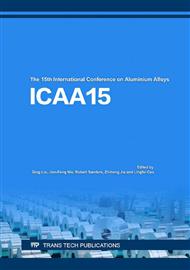p.258
p.264
p.275
p.281
p.290
p.296
p.303
p.310
p.315
Phase Composition, Texture and Mechanical Properties of 80 mm Plates of Al-2.8Cu-1.7Li-0.5Mg-0.5Zn-0.1Zr-0.06Sc Alloy
Abstract:
Phase composition, texture and mechanical properties of plates 80 mm thick from Al-2.8Cu-1.7Li-0.5Mg-0.5Zn-0.1Zr-0.06Sc alloy were investigated. It has been found that strength characteristics are maximum in median section (ultimate strength and the yield stress of 570 MPa and 540 MPa, respectively). In 0,25T section (where T is the plate thickness) these quantities make 530 MPa and 490 MPa, and in the short transverse direction of only 490 MPa and 440 MPa. Textural studies showed that on medium layer of a plate 0,3-0,35T thick is observed identical to a matrix and δ'-phase intensive single-component texture with an arrangement of the plane {011} parallel to the plate plane with domination of a "brass" texture component {110} <112>.
Info:
Periodical:
Pages:
290-295
Citation:
Online since:
November 2016
Authors:
Keywords:
Price:
Сopyright:
© 2017 Trans Tech Publications Ltd. All Rights Reserved
Share:
Citation:


